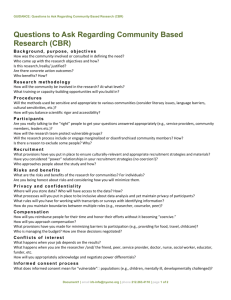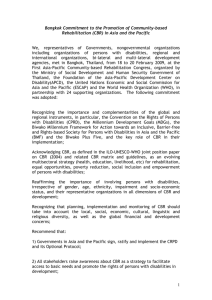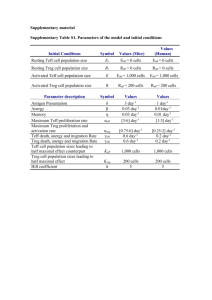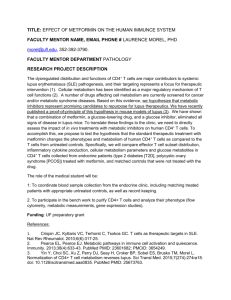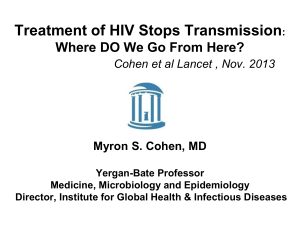meng_paper - eCommons@Cornell
advertisement
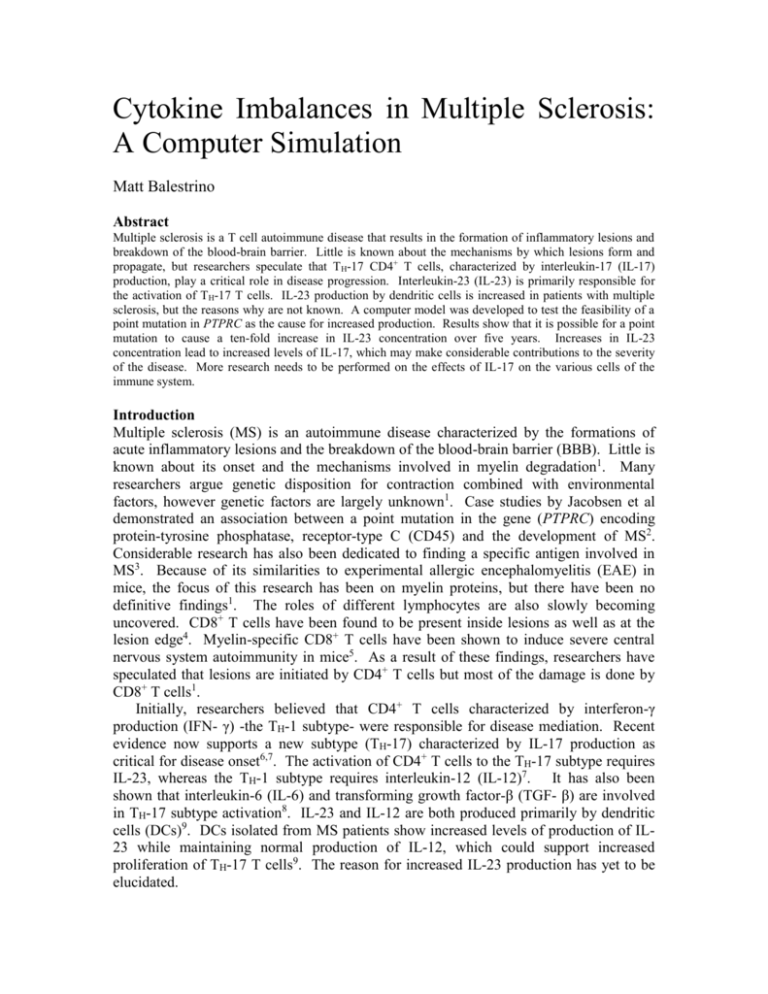
Cytokine Imbalances in Multiple Sclerosis:
A Computer Simulation
Matt Balestrino
Abstract
Multiple sclerosis is a T cell autoimmune disease that results in the formation of inflammatory lesions and
breakdown of the blood-brain barrier. Little is known about the mechanisms by which lesions form and
propagate, but researchers speculate that T H-17 CD4+ T cells, characterized by interleukin-17 (IL-17)
production, play a critical role in disease progression. Interleukin-23 (IL-23) is primarily responsible for
the activation of TH-17 T cells. IL-23 production by dendritic cells is increased in patients with multiple
sclerosis, but the reasons why are not known. A computer model was developed to test the feasibility of a
point mutation in PTPRC as the cause for increased production. Results show that it is possible for a point
mutation to cause a ten-fold increase in IL-23 concentration over five years. Increases in IL-23
concentration lead to increased levels of IL-17, which may make considerable contributions to the severity
of the disease. More research needs to be performed on the effects of IL-17 on the various cells of the
immune system.
Introduction
Multiple sclerosis (MS) is an autoimmune disease characterized by the formations of
acute inflammatory lesions and the breakdown of the blood-brain barrier (BBB). Little is
known about its onset and the mechanisms involved in myelin degradation1. Many
researchers argue genetic disposition for contraction combined with environmental
factors, however genetic factors are largely unknown1. Case studies by Jacobsen et al
demonstrated an association between a point mutation in the gene (PTPRC) encoding
protein-tyrosine phosphatase, receptor-type C (CD45) and the development of MS2.
Considerable research has also been dedicated to finding a specific antigen involved in
MS3. Because of its similarities to experimental allergic encephalomyelitis (EAE) in
mice, the focus of this research has been on myelin proteins, but there have been no
definitive findings1. The roles of different lymphocytes are also slowly becoming
uncovered. CD8+ T cells have been found to be present inside lesions as well as at the
lesion edge4. Myelin-specific CD8+ T cells have been shown to induce severe central
nervous system autoimmunity in mice5. As a result of these findings, researchers have
speculated that lesions are initiated by CD4+ T cells but most of the damage is done by
CD8+ T cells1.
Initially, researchers believed that CD4+ T cells characterized by interferon-γ
production (IFN- γ) -the TH-1 subtype- were responsible for disease mediation. Recent
evidence now supports a new subtype (TH-17) characterized by IL-17 production as
critical for disease onset6,7. The activation of CD4+ T cells to the TH-17 subtype requires
IL-23, whereas the TH-1 subtype requires interleukin-12 (IL-12)7. It has also been
shown that interleukin-6 (IL-6) and transforming growth factor-β (TGF- β) are involved
in TH-17 subtype activation8. IL-23 and IL-12 are both produced primarily by dendritic
cells (DCs)9. DCs isolated from MS patients show increased levels of production of IL23 while maintaining normal production of IL-12, which could support increased
proliferation of TH-17 T cells9. The reason for increased IL-23 production has yet to be
elucidated.
Studies have shown that CD45 negatively regulates the production of tumor necrosis
factor (TNF) and IL-6 by DCs10. In this study we hypothesize that increased IL-23
production by DCs in MS patients is a result of a point mutation in PTPRC causing DCs
to mimic activity of CD45-/- DCs. To assess this hypothesis we will use a computer
simulation of blood dynamics in both normal and MS patients.
Materials and Methods
MATLAB Student 7.0 was used to generate a simplified computer model of possible
onset of MS as dictated by cytokine concentrations. Focus was placed on DCs, activation
of CD4+ T cells, and interleukin secretion rates. TH-1, TH-2, and TH-17 subtypes were
considered. Regulatory T cells were assumed to be present as a constant fraction of total
CD4+ T cells. The doubling time of CD4+ T cells was estimated in order to obtain an
approximate steady state concentration of cells. CD45RA+ (naïve) T cell kinetics were
used, as naïve T cells have been found to produce more cytokines. The half-lives of IL17 and IL-23 were estimated based on half-lives of other interleukins within their
respective subfamilies. Little information was found pertaining to interleukin-4 (IL-4)
uptake and production by TH-2 CD4+ T cells.
Simulations were run to represent normal subjects and MS patients. MS patient
simulations included code to account for a point mutation in PTPRC causing the
increased levels of IL-23 production seen by DCs isolated from MS patients. Initially, all
DCs do not contain the mutation, and all CD4+ T cells are inactivated. Mutations were
introduced randomly, with the chance of mutation being 0.13%, consistent with the
chance of any normal person contracting MS (1 in 750). The computer program
calculated daily values of interleukin concentrations as well as CD4+ T cell subtype
populations for five years. Activation of CD4+ T cells was determined by concentration
of the primary interleukin found to be responsible (IL-12 for TH-1, IL-4 for TH-2, and IL23 for TH-17).
Threshold concentrations of interleukins required to activate one CD4+ T cell were
determined from previous research on cytokine production resulting from different initial
interleukin concentrations. For instance, if two different concentrations of IL-23 were
found to yield the same amount of IL-17, it was assumed that all of the cultured CD4+ T
cells were activated using the lower of the two concentrations.
The program was based on the following governing equations and parameters:
d (inact .CD4 )
(inactCD4 )( prolif .rate) (death.rate) (# cellsthatactivate)
dt
d (TH 1.CD4 )
(# cellsthatactivate) (TH 1.CD4 )[( death.rate) (reversion.rate)
dt
d (TH 2.CD4 )
(# cellsthatactivate) (TH 2.CD4 )[( death.rate) (reversion.rate)
dt
d (TH 17.CD4 )
(# cellsthatactivate) (TH 17.CD4 )[( death.rate) (reversion.rate)
dt
d ( IL17)
(TH 17.CD4 )(TH 17 production.rate) ( IL17)( IL17. deg radation.rate)
dt
d ( IL 23)
( DCs )( DC . production.rate) ( IL 23)( IL 23. deg radation.rate)
dt
d ( IL12)
( DCs )( DC . production.rate) ( IL12)( IL12. deg radation.rate)
dt
d ( IL 4)
(TH 2.CD4 )(TH 2 production.rate) ( IL 4)( IL 4. deg radation.rate)
dt
Parameter
Blood Volume
Value
4.5 L
CD4+ T cells In Blood
9E5 cells/mL
CD8+ T cells In Blood
6.5E5 cells/mL
Source
Accepted value
(estimated)
Accepted value
(estimated)
Accepted value
(estimated)
Dendritic Cells (DCs)
In Blood
2.5E4 cells/mL
[11]
Activated CD4+ T cell
Death Rate
0.057 cells/day
[12]
Activated CD4+ T cell
Reversion Rate
0.026 cells/day
[12]
Doubling time of CD4+
T cells
Half-life of CD4+ T
cells
8.31 days
Estimated
8.4 days
[13]
1.3078E-6 ng/cell/day
[9]
4.08E-7 ng/cell/day
[9]
0.58E-6 ng/cell/day
[9]
Rate of IL-12
0.53E-6 ng/cell/day
[9]
Th-17 Cell Secretion
Rate of IL-17 (MS
patients)
3.733E-7 ng/cell/day
[9]
1.41E-7 ng/cell/day
[9]
8.0E-7 ng/cell/day
Estimated
Th-17 Cell Secretion
Th-2 Cell Secretion
Rate of IL-4
8 hours
Half-life of IL-23
~8 hours
Half-life of IL-4
~4 hours
[14]
Estimated (same
subfamily as IL-12)
Estimated (could be
as low as .5 [17])
Half-life of IL-17
~8 hours
Estimated
IL-17
0 ng/mL
[16]
IL-4
0.0055 ng/mL
[17]
IL-23
0 ng/mL
[16]
IL-12
0.0093 ng/mL
[18]
8%
[19]
5E-6 ng/cell
[20]
3.4E-6 ng/cell
[21]
2E-6 ng/cell
Estimated
~3 days
[22]
Normal values of ILs in Blood
That are Treg
IL-23 to Activate
IL-12 to Activate
IL-4 to Activate
1 CD4+ T cell to Th-2
Normal DC Secretion
Rate of IL-17 (Normal)
Half-life of IL-12
1 CD4+ T cell to Th-1
Mutated DC Secretion
Rate of IL-12
Source
1 CD4+ T cell to Th-17
Normal DC Secretion
Rate of IL-23
Value
Percentage of CD4+ T cells
Mutated DC Secretion
Rate of IL-23
Parameter
Doubling Time of DCs
Results
Figure 1: Concentration of TH-1, TH-2, and TH-17 CD4+ T cell subtypes over five
years in a normal patient.
Figure 2: Concentration of TH-1, TH-2, and TH-17 CD4+ T cell subtypes over five
years in an MS patient.
Figure 3: Concentration of IL-17, IL-12, IL-23, and IL-4 over five years in a
normal patient.
Figure 4: Concentration of IL-17, IL-12, IL-23, and IL-4 over five years in an
MS patient.
TH-17 T cell concentration was found to be approximately 2800 cells/mL in normal
patients, roughly half of the TH-1 T cell concentration, ~5400 cells/mL (Figure 1). In
contrast, TH-17 T cell concentration in MS patients was 1400 cells/mL and still
increasing, with TH-1 concentration only slightly higher (Figure 2). TH-2 T cell
populations were largely unaffected, as were levels of IL-4. This is likely the result of
inadequate information on IL-4 secretion and uptake by TH-2 T cells, and the absence of
research on TH-2 T cells in MS.
IL-23 and IL-12 concentrations followed similar patterns to TH-17 and TH-1 T cell
concentrations, respectively. Both reached steady-state values in normal patients (10
pg/mL, 13.4 pg/mL), and IL-23 increased dramatically in MS (>50 pg/mL), while IL-12
only slightly increased (14 pg/mL) (Figures 3 & 4). IL-17 concentration reached a
steady-state value of 0.45 pg/mL in normal patients, which is consistent with normal
cytokine assays (IL-17 present in trace amounts). In MS, IL-17 concentration increased
dramatically to 6 pg/mL, and was still increasing after five years. As shown in Figure 5,
there is a linear relationship between IL-23 secretion rate by dendritic cells, and the
corresponding concentration of TH-17 T cells after five years.
Discussion
As seen from Figure 2, detectable amounts of IL-17 are present in the blood of MS
patients. However, these results are contradicted by cytokine assays taken from actual
patients. A possible cause for this discrepancy is the uptake of IL-17 by other cells not
accounted for in this model. IL-17 mRNA has been found to be more abundant in the
blood of MS patients23, which agrees with this possible cause. One can speculate that IL-
17 directly interacts with CD8+ T cells by an unknown mechanism, causing them to
attack myelin and form a lesion.
Concentrations of IL-12 and IL-4 in the blood of MS patients vary between
studies16,17,18. The results obtained from this model fall within the ranges reported by
several studies, but no definitive statement can be made. The cause of this is likely the
heterogeneity of the disease. Researchers have found that lesions resulting from MS
differ greatly from one another, even within one patient24. Cytokine concentrations
fluctuate with time and disease progression. Many studies classify patients as either
primary-progressive, relapse remitting, or secondary-progressive, even though it is likely
that large variations can be found within each group16.
The results obtained were largely influenced by the determine rates at which each
interleukin is secreted or degraded. This can be traced back to the simplification of the
processes involved. Constant rates of secretion and activation thresholds were used in
order to make this simulation feasible. Since most of the activation mechanisms are
unknown, it is difficult to correctly interpret exactly how cells react in the presence of
cytokines. Also, this model assumes that all cells are exposed to an antigen that causes
them to secrete cytokines all the time (they are “always on”), which is not true. At any
given point, only a fraction of lymphocytes and granulocytes will be exposed to the same
antigen, causing them to secrete similar amounts of cytokine.
Another limitation of this model was the use of a daily iteration. Most interleukins
have half-lives of less than 1 day, (< 1 hour for IL-417), so interactions between cells and
interleukins would be more correctly interpreted on a smaller time scale. Also, the
interaction between different cytokines was not considered, as well as the effect of
multiple cytokines on one specific cell. Because of the numerous feedback mechanisms
within the immune system, a model cannot account for every action of a specific cell
without including the entire system. All of these factors make it increasingly difficult to
adequately model processes of the immune system.
Since the onset and progression of multiple sclerosis is still unclear, there is much
room for improvement through research. This study attempted to explain the imbalances
of cytokines in the blood of patients who have MS through computer simulation. Future
research can build off of this model by including more pieces of the immune system and
the cells involved in order to obtain a more accurate interpretation of what is occurring.
The inclusion of feedback mechanisms would likely result in pseudo-steady-state results,
which better describe cytokine levels in the blood. One possibility is the use of stochastic
modeling, or modeling randomness. This would allow the programmer to calculate the
probability of random collision between a given cell and antigen, eliminating the need for
the “always on” assumption.
Future laboratory research should focus on the importance of IL-17 in multiple
sclerosis. Researchers can confirm a point mutation in the PTPRC as the cause of
increased IL-23 production in DCs and could eliminate the mutation through gene
therapy. Also, studies can be performed to examine the effects of IL-17 on other cells of
the immune system, such as CD8+ T cells. The increased amount of IL-17 mRNA in the
blood of MS patients shows not only that IL-17 is being produced at an above normal
rate, but it is also being consumed or degraded. These findings could allow researchers
to uncover the mechanisms behind MS onset and lesion formation.
References
1.
2.
3.
4.
5.
6.
7.
8.
9.
10.
11.
12.
13.
14.
15.
16.
17.
18.
19.
20.
21.
22.
23.
McFarland, H.F., & Martin, R. Multiple sclerosis: a complicated picture of autoimmunity. Nature
Immunology 2007; 8(9): 913-919.
Jacobsen, M. et al. A point mutation in PTPRC is associated with the development of multiple sclerosis.
Nature Genetics 2000; 26: 495-499.
Ota, K., Matsui, M., Milford, E.L., Mackin, G.A., Weiner, H.L. & Hafler, D.A. T-cell recognition of an
immuno-dominant myelin basic protein epitope in multiple sclerosis. Letters to Nature 1990; 346: 183-187.
Traugott, U., Reinherz, E.L., & Raine, C.S. Multiple Sclerosis: distribution of T cell subsets within active
chronic lesions. Science 1983; 219: 308-310.
Huseby, E.S., Liggitt, D., Brabb, T., Schnabel, B., Ohlen, C. & Goverman, J. A Pathogenic Role for Myelinspecific CD8+ T Cells in a Model for Multiple Sclerosis. J. Exp. Med. 2001; 194(5): 669-676.
McKenzie, B.S., Kastelein, R.A., & Cua, D.J. Understanding the IL-23-IL-17 immune pathway. Trends
Immunology 2006; 27: 17-23.
Harrington, L.E., Hatton, R.D., Mangan, P.R., Turner, H., Murphy, T.L., Murphy, K.M., & Weaver, C.T.
Interleukin 17-producting CD4+ effector T cells develop via a lineage distinct from the T help type 1 and 2
lineages. Nature Immunology 2005; 6(11): 1123-1132.
Veldhoen, M., Hocking, R.J., Atkins, C.J., Locksley, R.M. & Stockinger, B. TGFbeta in the context of an
inflammatory cytokine milieu supports de novo differentiation of IL-17-producing T cells. Immunity 2006;
24: 179-189.
Vaknin-Dembinsky, A., Balashov, K., & Weiner, H.L. IL-23 Is Increased in Dendritic Cells in Multiple
Sclerosis and Down-Regulation of IL-23 by Antisense Oligos Increases Dendritic Cell IL-10 Production.
Journal of Immunology 2006; 176: 7768-7774.
Piercy, J., Petrova, S., Tchilian, E.Z., & Beverley, P.C.L. CD45 negatively regulates tumour necrosis factor
and interleukin-6 production in dendritic cells. Immunology 2006; 118: 250-256.
Haller Hasskamp, J, Zapas, J.L., & Elias, E.G. Dendritic cell counts in the peripheral blood of healthy adults.
American Journal of Hematology 2005 Apr; 78(4): 314-5
Ribeiro, R.M., Mohri, H., Ho, D.D., & Perelson, A.S. In vivo dynamics of T cell activation, proliferation,
and death in HIV-1 infection: Why are CD4+ but not CD8+ T cells depleted? PNAS 2002 Nov; 99(24):
15572-15577.
Wallace, D.L., et al. Direct Measurement of T Cell Subset Kinetics In vivo in Elderly Men and Women.
Journal of Immunology 2004; 173: 1787-1794.
Xu, Y.X., Gao, X., Janakiraman, N., Chapman, R.A., & Gautam, S.C. IL-12 Gene Therapy of Leukemia
with Hematopoietic Progenitor Cells without the Toxicity of Systemic IL-12 Treatment. Clinical
Immunology 2001 Feb; 98(2): 180-189.
Finkelman, F.D., Madden, K.B., Morris, S.C., Holmes, J.M., Boiani, N, Katona, I.M., & Maliszewski, C.R.
Anti-Cytokine Antibodies as Carrier Proteins: Prolongation of in vivo Effects of Exogenous Cytokines by
Injection of Cytokine-Anti-Cytokine Antibody Complexes. Journal of Immunology 1993 Aug; 151: 12351244.
Ukkonen, M., Wu, X., Reipert, B., Dastidar, P., & Elovaara, I. Cell surface adhesion molecules and cytokine
profiles in primary progressive multiple sclerosis. Multiple Sclerosis 2007; 13: 701-707.
Kim, Y-K, Myint, A-M, Lee, B-H, Han, C-S, Lee, H-J, Kim, D-J, & Leonard, B.E. Th1, Th2, and Th3
cytokine alteration in schizophrenia. Progress in Neuro-Psychopharmacology & Biological Psychiatry 2004;
28: 1129-1134.
Kim, Y-K, Suh, I-B, Kim, H., Han, C-S, Lim, C-S, Choi, S-H, & Licinio, J. The plasma levels of interleukin12 in schizophrenia, major depression, and bipolar mania: effects of psychotropic drugs. Molecular
Psychiatry 2002; 7: 1107-1114.
Putheti, P., Pettersson, A., Soderstrom, M., Link, H, & Huang, Y.M. Circulating CD4 +CD25+ T Regulatory
Cells Are Not Altered in Multiple Sclerosis and Unaffected by Disease-Modulating Drugs. Clinical
Immunology 2004; 24(2): 155-161.
Aggarwal, S., Ghilardi, N., Xie, M-H, Sauvage, F.J., & Gurney, A.L. Interleukin-23 Promotes a Distinct
CD4 T Cell Activation State Characterized by the Production of Interleukin-17. Biological Chemistry 2003;
278(3): 1910-1914.
Sasama, J., Vyas, B., Vukmanovic-Stejic, M., & Kemeny, D.M. Effect of IL-4, IFN-γ and IL-12 on Cytokine
Production from Human CD45RA and CD45RO CD4 T Cell Precursors. Int Arch Allergy Immunology
1998; 117: 255-262.
Winzler, C., Rovere, P., Rescigno, M., Granucci, F., Penna, G., Adorini, L., Zimmermann, V.S., Davoust, J.,
& Ricciardi-Castagnoli, P. Maturation Stages of Mouse Dendritic Cells in Growth Factor- dependent LongTerm Cultures. J. Exp. Med. 1997; 185(2): 317-328.
Matusevicius, D. et al. Interleukin-17 mRNA expression in blood and CSF mononuclear cells is augmented
in multiple sclerosis. Mult. Scler. 1999; 5: 101-104.
24. Lucchinetti, C., Bruck, W., Parisi, J., Scheithauer, B., Rodriguez, M., & Lassmann, H. Heterogeneity of
Multiple Sclerosis Lesions: Implications for the Pathogenesis of Demyelination. American Neurological
Association 2000; 707-717.
Appendix
Bulk code
%function [IL23f, Th17f] = Meng_new(IL23rate)
% Matt Balestrino
%clc;clear;
%%%%%%%%%%%%%%%%%%%%%%%%%%%%%%%%%%%%%%%%%%%
%%%%%%%%%%%%%%%%%%%%%%%%%%%%%%%%
% Parameters and Initial Conditions
%%%%%%%%%%%%%%%%%%%%%%%%%%%%%%%%%%%%%%%%%%%
%%%%%%%%%%%%%%%%%%%%%%%%%%%%%%%%
Bvol = 4.5;
% Volume of blood, L
actdeath = 0.057;
% Death rate of activated CD4+ T cells, /day
reversion_rate = .026;
% Rate at which activated T cells revert to
% the inactivated state, /day
dble_time_CD4 = 28.5;
% Double time of inact. CD4 cells, days
half_life_CD4 = 8.4;
% Half life of inactivated CD4 cells, days
dble_time_CD8 = 17.9;
% Double time of inact. CD8 cells, days
half_life_CD8 = 9.3;
% Half life of inactivated CD8 cells, days
%IL23_DC_sec_mut = IL23rate; % Secretion of IL-23 per DC in MS, ng/day
IL23_DC_sec_mut = 3.3078E-6;
IL23_DC_sec_norm = 4.08E-7; % Secretion of IL-23 per DC normally, ng/day
IL12_DC_sec_mut = .58E-6; % Secretion of IL-12 per DC in MS, ng/day
IL12_DC_sec_norm = .536E-6; % Secretion of IL-12 per DC normally, ng/day
IL17_Tc_sec_MS = 3.733E-7; % Secretion of IL-17 per Tcell in MS, ng/day
IL17_Tc_sec_norm = 1.41E-7; % Secretion of IL-17 per Tcell norm., ng/day
IL4_Tc_sec_rate = 8E-7;
% *****Secretion of IL-4 per T cell, ng/day
IL12_deg_rate = 0.875;
% Percentage of IL-12 that degrade, /day
IL4_deg_rate = 0.984;
% *****Percentage of IL-4 that degrade, /day
IL23_deg_rate = 0.875;
% Percentage of IL-23 that degrade, /day
IL17_deg_rate = 0.875;
% *****Percentage of IL-17 that degrade, /day
DC(1) = 2.5E4;
% Number of dendritic cells in blood /mL
CD4 = 9E5;
% Number of CD4+ T cells in blood, /mL
CD8 = 6.5E5;
% Number of CD8+ T cells in blood, /mL
% Initial conditions
IL17(1) = 0;
IL4(1) = 0.0055;
IL23(1) = 0;
IL12(1) = .0093;
% [IL-17] in blood, ng/mL
% [IL-4] in blood, ng/mL
% [IL-23] in blood, ng/mL
% [IL-12] in blood, ng/mL
% Assume there are no activated CD4 T cells initially
Th1(1) = 0;
Th2(1) = 0;
Th17(1) = 0;
% Assume no dendritic cells are mutated initially
tot_mutated_DC(1) = 0;
% Regulatory T cells are present at a constant ratio, ~8%
Treg = CD4*.08;
act = 0;
% Initial number of inactivated CD4 T cells
inact(1) = CD4 - Th1(1) - Th2(1) - Th17(1) - Treg;
% Amount of IL-23 that cause 1 T cell to activate to Th17
IL23_thres = 5E-6;
% ng/cell
% Amount of IL-12 that cause 1 T cell to activate to Th1
IL12_thres = 3.4E-6;
% ng/cell
% *****Amount of IL-4 that cause 1 T cell to activate to Th2
IL4_thres = 2E-6;
% ng/cell
%%%%%%%%%%%%%%%%%%%%%%%%%%%%%%%%%%%%%%%%%%%
%%%%%%%%%%%%%%%%%%%%%%%%%%%%%%%%
% Calculations
%%%%%%%%%%%%%%%%%%%%%%%%%%%%%%%%%%%%%%%%%%%
%%%%%%%%%%%%%%%%%%%%%%%%%%%%%%%%
% Run simulation for 5 years
days = 1825;
for day = 2:days
% Determine if any CD4+ T cells activate
% Activation to Th-17 type
if IL23(day-1)*(1-IL23_deg_rate) > IL23_thres
IL23left = mod(IL23(day-1)*(1-IL23_deg_rate),IL23_thres);
Th17(day) = Th17(day-1) + (IL23(day-1)*...
(1-IL23_deg_rate)-IL23left)/IL23_thres;
act = act + (IL23(day-1)*(1-IL23_deg_rate)-IL23left)/IL23_thres;
IL23(day) = IL23left;
else
Th17(day) = Th17(day-1);
IL23(day) = IL23(day-1);
end
% Activation to Th-1 type
if IL12(day-1)*(1-IL12_deg_rate) > IL12_thres
IL12left = mod(IL12(day-1)*(1-IL12_deg_rate),IL12_thres);
Th1(day) = Th1(day-1) + (IL12(day-1)*...
(1-IL12_deg_rate)-IL12left)/IL12_thres;
act = act + (IL12(day-1)*(1-IL12_deg_rate)-IL12left)/IL12_thres;
IL12(day) = IL12left;
else
Th1(day) = Th1(day-1);
IL12(day) = IL12(day-1);
end
% Activation to Th-2 type
if IL4(day-1)*(1-IL4_deg_rate) > IL4_thres
IL4left = mod(IL4(day-1)*(1-IL4_deg_rate),IL4_thres);
Th2(day) = Th2(day-1) + (IL4(day-1)*...
(1-IL4_deg_rate)-IL4left)/IL4_thres;
act = act + (IL4(day-1)*(1-IL4_deg_rate)-IL4left)/IL4_thres;
IL4(day) = IL4left;
else
Th2(day) = Th2(day-1);
IL4(day) = IL4(day-1);
end
% Determine how many cells revert to inactivated state
reverted_cells(day) = (Th1(day-1)+Th2(day-1)+Th17(day-1))*...
reversion_rate;
% Determine how many inactivated CD4+ T cells there are
[t,xx] = ode45(@inactCD4,[day-1,day],[inact(day-1)],[],act,...
reverted_cells(day));
inact(day) = xx(length(xx));
% Correct for negative values
if inact(day) < 0
inact(day) = 0;
end
% Reset the number of activated cells
act = 0;
% Calculate how much IL-23 and IL-12 is being produced depending on
% number of mutated dendritic cells
IL23(day) = IL23(day) + IL23_DC_sec_mut*tot_mutated_DC(day-1) + ...
IL23_DC_sec_norm*DC(day-1);
IL12(day) = IL12(day) + IL12_DC_sec_mut*tot_mutated_DC(day-1) + ...
IL12_DC_sec_norm*DC(day-1);
% Calculate how much IL-17 is being produced
% If looking at mutated, comment out the second equation
% If not, comment the first one
% IL17(day) = IL17(day-1)*(1-IL17_deg_rate) + IL17_Tc_sec_MS*...
%
Th17(day-1);
IL17(day) = IL17(day-1)*(1-IL17_deg_rate) + IL17_Tc_sec_norm*...
Th17(day-1);
% Calculate how much IL-4 is being produced
IL4(day) = IL4(day) + IL4_Tc_sec_rate*Th2(day-1)+ IL4(1);
% Calculate how many dendritic cells mutate, if any
% Dendritic cell population turnover ~ 1/3 times/day
% If mutated comment out the two lines after the if statement
% If not, comment out the entire if statement
% if mod(day, 3) == 0 %Can only add mutations every 3 days
%
if DC(day-1) > 0
%
q = rand(1, DC(day-1));
%
mutated_DC = sum(q<=1/750);
%
DC(day) = DC(day-1) - mutated_DC;
%
tot_mutated_DC(day) = tot_mutated_DC(day-1) + mutated_DC;
%
q=0;
%
if DC(day) < 0
%
DC(day) = 0;
%
end
%
else
%
DC(day) = DC(day-1);
%
tot_mutated_DC(day) = tot_mutated_DC(day-1);
%
end
% else
%
DC(day) = DC(day-1);
%
tot_mutated_DC(day) = tot_mutated_DC(day-1);
% end
DC(day) = DC(day-1);
tot_mutated_DC(day) = 0;
% Adjust the activated T cells lines for death and reversion
Th1(day) = Th1(day) - Th1(day)*(actdeath + reversion_rate);
Th2(day) = Th2(day) - Th2(day)*(actdeath + reversion_rate);
Th17(day) = Th17(day) - Th17(day)*(actdeath + reversion_rate);
% Adjust for negative values
if Th1(day) < 0
Th1(day) = 0;
end
if Th2(day) < 0
Th2(day) = 0;
end
if Th17(day) < 0
Th17(day) = 0;
end
end % End for loop
IL23f = IL23(length(IL23));
Th17f = Th17(length(Th17));
%%%%%%%%%%%%%%%%%%%%%%%%%%%%%%%%%%%%%%%%%%%
%%%%%%%%%%%%%%%%%%%%%%%%%%%%%%%%
% Displaying results
%%%%%%%%%%%%%%%%%%%%%%%%%%%%%%%%%%%%%%%%%%%
%%%%%%%%%%%%%%%%%%%%%%%%%%%%%%%%
x = 1:days;
figure(1);
plot(x,Th1,x,Th2,'r',x,Th17,'g')
xlabel('Time, days')
ylabel('Cells/mL')
title('Changing Concentrations of Activated CD4^+ T cells')
legend('Th1','Th2','Th17')
figure(2);
subplot(2,2,1)
plot(x,IL17*1000)
xlabel('Time, days')
ylabel('[IL-17], pg/mL')
subplot(2,2,2)
plot(x,IL12*1000)
xlabel('Time, days')
ylabel('[IL-12], pg/mL')
subplot(2,2,3)
plot(x,IL23*1000)
xlabel('Time, days')
ylabel('[IL-23], pg/mL')
subplot(2,2,4)
plot(x,IL4*1000)
xlabel('Time, days')
ylabel('[IL-4], pg/mL')
%end % End program
InactCD4 function
function dx = inactCD4(t,x,act,reverted)
% This function models the change in population of unactivated CD4+ T cells
% using double time and half life and inputs of # of activated cells and #
% of cells that revert back to unactivated state
%%%%%%%%%%%%%%%%
% Variables
%%%%%%%%%%%%%%%%
% Th1:
number of Th-1 activated CD4 T cells
% Th2:
number of Th-2 activated CD4 T cells
% Th17: number of Th-17 activated CD4 T cells
% act:
number of cells that became activated last cycle
% revereted: number of cells that reverted back to unactivated state
double_time = 8.31; % doubling time of CD4 cells, days
half_life = 8.4; % half life of CD4 cells, days
reversion = .026;
dx(1) = x(1)*(log(2)/double_time-log(2)/half_life) + reverted - act;
end
Calling code
IL23_DC_sec_mut = 1.3078E-6;
IL23rate = linspace(1E-7,3E-6,200);
for index = 1:length(IL23rate)
[IL23f(index), Th17f(index)] = Meng_new(IL23rate(index));
end
plot(IL23rate, Th17f)
xlabel('IL23 Secretion Rate per Dendritic Cell, ng/day')
ylabel('Number of Th17 T cells per mL of Blood After 5 years')



